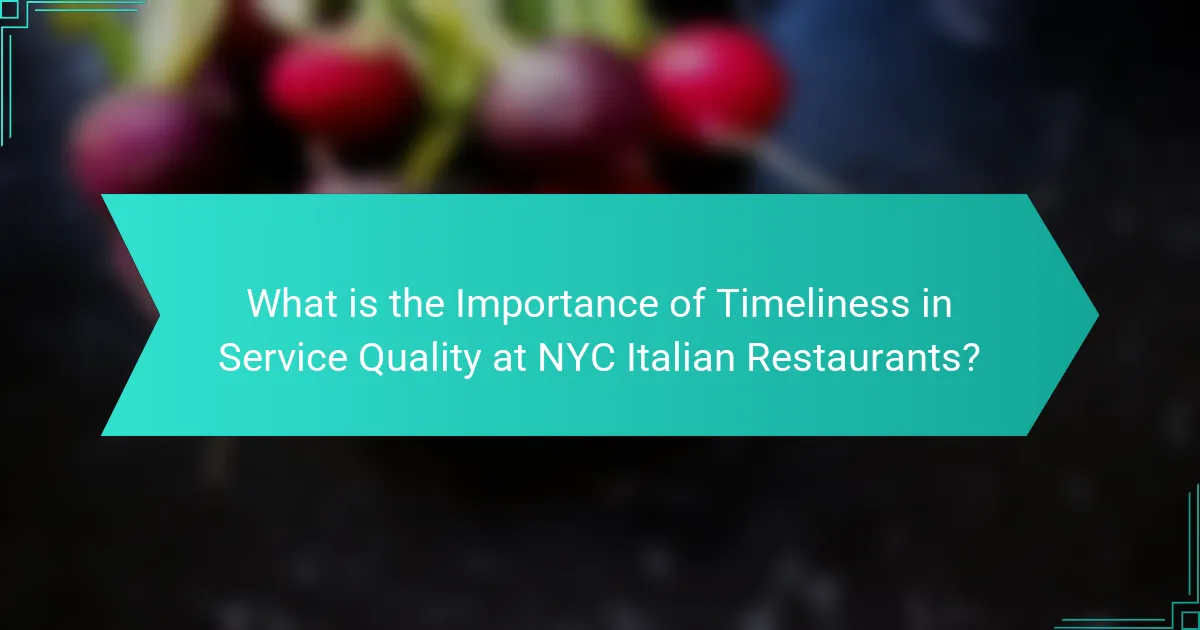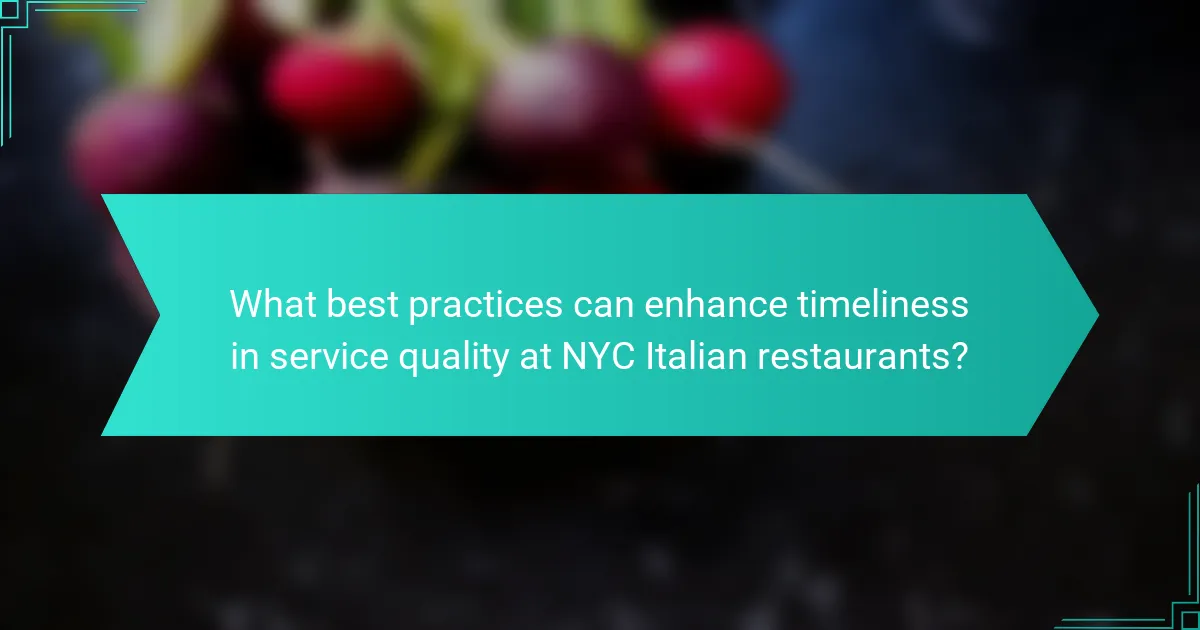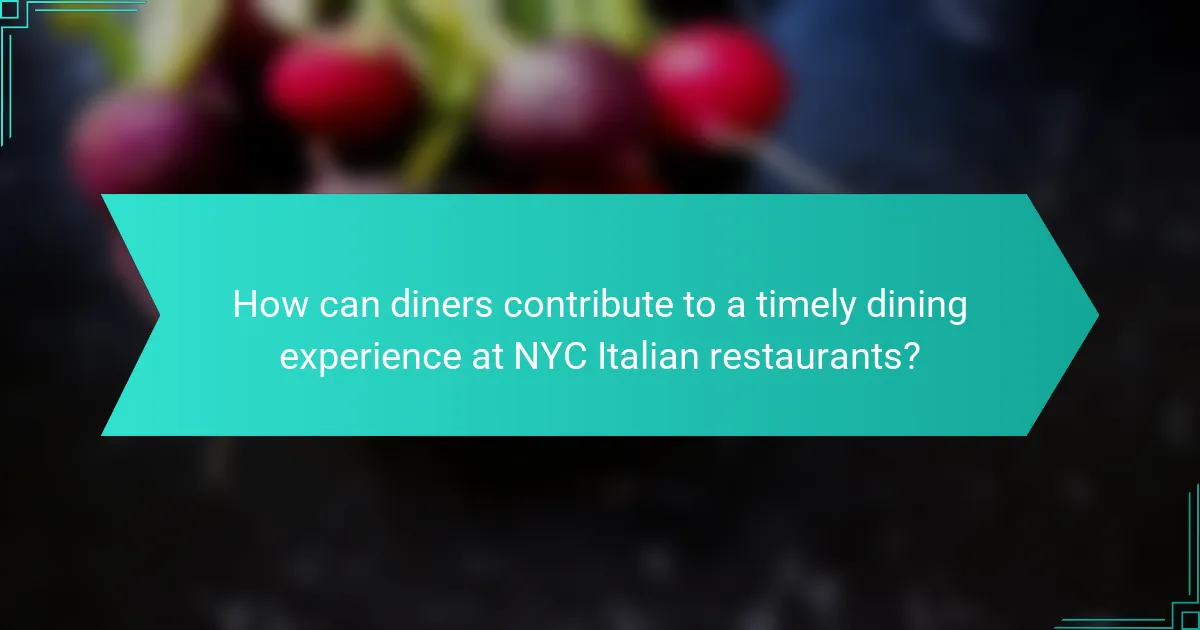Timeliness is a critical factor in the service quality of NYC Italian restaurants, significantly influencing customer satisfaction and overall dining experiences. Prompt service ensures food is served at optimal temperatures and enhances enjoyment through quick responses to customer requests. Research indicates that 75% of diners prioritize speed of service, making it a vital aspect for repeat business in a competitive market. Efficient staff training, technology adoption for order management, and streamlined menus can improve service speed. Additionally, diners can enhance their experience by making reservations, arriving on time, and communicating effectively with restaurant staff.

What is the Importance of Timeliness in Service Quality at NYC Italian Restaurants?
Timeliness is crucial for service quality at NYC Italian restaurants. It directly impacts customer satisfaction and dining experience. Prompt service ensures that food is served at optimal temperatures. Quick response times to customer requests enhance overall enjoyment. Research shows that timely service can increase repeat visits. According to a study by the National Restaurant Association, 75% of diners consider speed of service important. In a competitive market like NYC, timeliness can differentiate a restaurant. When service is delayed, it can lead to negative reviews and loss of business. Thus, maintaining timeliness is essential for success in the restaurant industry.
How does timeliness influence customer satisfaction in NYC Italian restaurants?
Timeliness significantly influences customer satisfaction in NYC Italian restaurants. Prompt service enhances the dining experience and meets customer expectations. Customers often associate timely service with professionalism and efficiency. A study by the Cornell University School of Hotel Administration found that wait times directly impact customer satisfaction ratings. Specifically, longer wait times can lead to negative perceptions of food quality and overall experience. In contrast, quick service can lead to repeat visits and positive reviews. Thus, maintaining timely service is crucial for customer retention in this competitive market.
What specific aspects of service quality are affected by timeliness?
Timeliness directly affects several aspects of service quality in NYC Italian restaurants. These aspects include customer satisfaction, service efficiency, and perceived value. When services are delivered promptly, customer satisfaction increases significantly. A study by the American Customer Satisfaction Index indicates that timely service is a key driver of overall satisfaction ratings.
Service efficiency also improves with timeliness. Quick service allows restaurants to accommodate more customers, thereby enhancing operational efficiency. According to industry reports, restaurants that prioritize timely service can increase their table turnover rates by up to 30%.
Perceived value is another aspect influenced by timeliness. Customers often associate prompt service with higher quality. Research shows that diners are willing to pay more for meals served in a timely manner. This willingness to pay more can lead to increased revenue for restaurants.
In summary, timeliness impacts customer satisfaction, service efficiency, and perceived value in NYC Italian restaurants. These elements collectively contribute to a better overall dining experience.
How does the perception of wait times impact diners’ experiences?
Perception of wait times significantly impacts diners’ experiences. Longer perceived wait times can lead to frustration and dissatisfaction. Research indicates that diners often equate wait time with service quality. A study by Kwortnik and Thompson found that perceived wait times can negatively influence overall dining satisfaction. Additionally, diners may form expectations about food quality and service based on wait times. For instance, a wait of over 30 minutes can lead to decreased likelihood of return visits. Effective communication about wait times can mitigate negative perceptions. Clear updates can enhance the overall experience, making diners feel valued.
Why is timeliness a critical factor in the competitive landscape of NYC Italian dining?
Timeliness is critical in NYC Italian dining due to high customer expectations. Diners in New York City often seek prompt service, especially during peak hours. Quick service can significantly enhance the dining experience and influence customer satisfaction. Studies show that timely service correlates with higher ratings and repeat visits. According to a survey by the National Restaurant Association, 70% of diners expect their meals within 30 minutes. In a competitive market, restaurants that consistently deliver timely service can differentiate themselves. This can lead to positive reviews and increased word-of-mouth referrals. Thus, timeliness directly impacts a restaurant’s success and reputation in NYC’s vibrant dining scene.
What role does timeliness play in customer retention for Italian restaurants?
Timeliness significantly influences customer retention for Italian restaurants. Prompt service enhances the dining experience and meets customer expectations. Customers value quick food delivery and attentive service. Research shows that 70% of diners consider speed crucial for repeat visits. Delays can lead to dissatisfaction and negative reviews. Fast service fosters a positive atmosphere, encouraging customers to return. Timeliness also contributes to operational efficiency, allowing restaurants to serve more guests. Overall, timely service is essential for building customer loyalty in Italian dining establishments.
How do timely services differentiate successful NYC Italian restaurants from others?
Timely services differentiate successful NYC Italian restaurants by enhancing customer satisfaction and loyalty. Quick service leads to a positive dining experience. Customers value prompt attention and timely food delivery. Research shows that restaurants with faster service report higher customer retention rates. According to a study by the National Restaurant Association, 70% of diners prioritize speed in service. This efficiency creates a competitive advantage in a crowded market. Successful Italian restaurants often implement staff training focused on speed and efficiency. They also utilize technology for order management to streamline operations. Overall, timely service is crucial for success in the NYC Italian dining scene.
What are the challenges of maintaining timeliness in service at NYC Italian restaurants?
The challenges of maintaining timeliness in service at NYC Italian restaurants include high customer volume and staffing shortages. NYC restaurants often experience peak dining hours with large crowds. This influx can overwhelm staff, leading to delays in service. Additionally, many Italian restaurants prioritize traditional cooking methods. These methods can be time-consuming, impacting overall service speed. The complexity of menu items also contributes to longer preparation times. Furthermore, unexpected issues such as supply chain disruptions can hinder timely service. Weather conditions and local events may also affect customer flow and staff availability. These factors collectively challenge the ability to deliver prompt service in NYC Italian dining establishments.
What common obstacles do restaurant staff face in delivering timely service?
Restaurant staff commonly face obstacles such as high customer volume, staff shortages, and kitchen delays in delivering timely service. High customer volume can overwhelm staff, leading to longer wait times. Staff shortages, whether due to illness or turnover, reduce the available workforce. Kitchen delays often occur due to equipment malfunctions or inefficient food preparation processes. These factors cumulatively hinder the ability to serve customers promptly. Research indicates that restaurants with high turnover rates experience slower service times, impacting customer satisfaction.
How can restaurants effectively manage peak hours to ensure timely service?
Restaurants can effectively manage peak hours by optimizing staff schedules and streamlining operations. Proper staff scheduling ensures adequate coverage during busy times. This can involve analyzing historical data to predict peak hours. Implementing a reservation system can also help manage customer flow. Offering limited menus during peak times can speed up service. Training staff to work efficiently under pressure is essential. Utilizing technology for order management can reduce wait times. Regularly reviewing service processes identifies areas for improvement. These strategies lead to improved customer satisfaction and timely service.

What best practices can enhance timeliness in service quality at NYC Italian restaurants?
Implementing efficient staff training enhances timeliness in service quality at NYC Italian restaurants. Well-trained staff can manage customer expectations effectively. They can quickly assess and respond to dining needs. Adopting technology for order management streamlines service delivery. Systems like point-of-sale (POS) can reduce wait times significantly. Regularly reviewing and optimizing menu items aids in service speed. Simplified menus allow for quicker preparation and order fulfillment. Establishing clear communication channels among staff ensures seamless service. This coordination minimizes delays during peak hours. Data from the National Restaurant Association indicates that timely service directly influences customer satisfaction.
How can restaurant management improve service timing?
Restaurant management can improve service timing by optimizing workflow and staff training. Streamlining kitchen operations reduces food preparation time. Implementing a reservation system helps manage customer flow effectively. Training staff on efficient service techniques enhances table turnover rates. Regularly reviewing service processes identifies bottlenecks. Utilizing technology, such as POS systems, speeds up order processing. Monitoring service times allows for adjustments to be made promptly. These strategies can lead to increased customer satisfaction and repeat business.
What training methods can be implemented to enhance staff efficiency?
On-the-job training, workshops, and e-learning are effective methods to enhance staff efficiency. On-the-job training allows employees to learn in real-time while performing their tasks. This method increases practical skills and reduces the learning curve. Workshops provide structured learning environments where staff can engage in skill-building activities. These sessions can focus on specific areas such as customer service or food preparation. E-learning offers flexibility, allowing staff to access training materials at their convenience. This method supports varied learning paces and can be updated frequently. Research shows that organizations investing in training see a 24% higher profit margin. Implementing these methods can lead to improved service quality and efficiency at NYC Italian restaurants.
How can technology be leveraged to streamline service processes?
Technology can be leveraged to streamline service processes by automating tasks and improving communication. Automation tools can handle repetitive tasks, reducing the time staff spend on manual processes. For example, online reservation systems allow customers to book tables without phone calls. This feature saves time for both customers and restaurant staff.
Additionally, point-of-sale (POS) systems can speed up order taking and payment processing. These systems minimize errors and enhance efficiency. Mobile ordering apps enable customers to place orders from their devices, reducing wait times.
Data analytics can also optimize inventory management. By predicting demand, restaurants can minimize waste and ensure timely service. According to a report by the National Restaurant Association, technology adoption can increase operational efficiency by up to 30%.
Overall, integrating technology into service processes leads to faster service and improved customer satisfaction.
What strategies can be employed to communicate wait times effectively to customers?
To communicate wait times effectively to customers, restaurants should use clear and transparent messaging. Providing estimated wait times at the point of entry helps manage expectations. Digital displays or signage can show real-time updates on wait times. Staff should regularly inform customers about any changes in wait duration. Utilizing mobile apps to send notifications about table readiness enhances communication. Engaging customers with complimentary items during long waits can improve their experience. Studies show that clear communication reduces customer anxiety and increases satisfaction. For example, a report by the Journal of Service Research highlights that transparency in wait times leads to higher customer retention rates.
How does transparency in wait times affect customer expectations?
Transparency in wait times positively affects customer expectations. It allows customers to have realistic anticipations about their service experience. When customers are informed about wait times, they feel more in control. Research indicates that clear communication reduces anxiety and frustration. A study by the Journal of Service Research found that transparency leads to higher satisfaction levels. Customers are more likely to return when they trust the service provider. This trust is built through consistent and honest communication. Overall, transparency in wait times enhances the overall dining experience.
What tools can be used to keep customers informed about their service status?
Email notifications are effective tools to keep customers informed about their service status. These notifications can provide real-time updates on order progress. SMS alerts are another practical option for timely communication. They can deliver quick status changes directly to customers’ mobile devices. Mobile apps can also be utilized for tracking service status. Customers can receive push notifications through these apps. Social media platforms serve as additional channels for service updates. Restaurants can post timely information about service status on their pages. Live chat features on websites can provide instant communication regarding service inquiries. Each of these tools enhances customer engagement and satisfaction by ensuring they are informed.

How can diners contribute to a timely dining experience at NYC Italian restaurants?
Diners can contribute to a timely dining experience at NYC Italian restaurants by making reservations in advance. This helps restaurants manage their seating and service flow effectively. Arriving on time for reservations allows for a smoother dining experience. Diners should also communicate any changes to their party size promptly. This information helps the restaurant adjust its plans accordingly. Ordering appetizers and main courses in advance can speed up service. Finally, being courteous and understanding during busy times enhances overall efficiency. These actions collectively improve the dining experience for everyone involved.
What are the best practices for diners to ensure timely service?
To ensure timely service, diners should arrive on time for their reservations. This practice respects the restaurant’s schedule and helps maintain a smooth flow of service. Diners should also communicate any special requests when making reservations. This allows the kitchen to prepare in advance. Ordering promptly after being seated is essential. It minimizes delays in food preparation and service. Additionally, diners should be mindful of peak dining hours. Visiting during off-peak times can lead to faster service. Paying the bill promptly after dining helps clear the table for the next guests. Engaging politely with staff can also enhance service speed. Research shows that courteous interactions lead to more efficient service.
How can making reservations impact service timing?
Making reservations can significantly impact service timing by ensuring that restaurants can manage their guest flow effectively. When a reservation is made, the restaurant can prepare for the expected number of diners. This preparation includes staffing appropriately and setting up tables in advance.
As a result, guests with reservations typically experience shorter wait times upon arrival. A study from the National Restaurant Association indicates that 70% of diners prefer restaurants that accept reservations, highlighting the demand for timely service.
Additionally, reservations allow restaurants to allocate their resources efficiently. This leads to a smoother dining experience and enhanced customer satisfaction. Thus, making reservations directly contributes to improved service timing in NYC Italian restaurants.
What role does clear communication with staff play in enhancing service efficiency?
Clear communication with staff significantly enhances service efficiency in NYC Italian restaurants. It ensures that all team members understand their roles and responsibilities. When staff members are well-informed, they can respond quickly to customer needs. This reduces wait times and improves overall customer satisfaction. Studies show that effective communication can lead to a 25% increase in productivity. Additionally, clear instructions help prevent misunderstandings that could disrupt service flow. Efficient service directly correlates with positive dining experiences, fostering repeat business. Therefore, prioritizing clear communication is essential for operational success in the restaurant industry.
What tips can enhance the overall dining experience related to timeliness?
Arriving on time for a reservation enhances the overall dining experience. It allows for a smooth seating process and reduces wait times. Communicating with the restaurant about delays is crucial. This helps the staff manage expectations and adjust seating arrangements. Ordering appetizers and drinks promptly can expedite service. This can lead to quicker meal preparation and delivery. Being mindful of dining duration is also important. It ensures that the table is available for subsequent guests. Lastly, paying the bill promptly contributes to efficient service flow. Timeliness in dining improves guest satisfaction and operational efficiency.
How can diners adjust their expectations based on restaurant peak times?
Diners can adjust their expectations based on restaurant peak times by recognizing that service may be slower during busy hours. During peak times, such as weekends or holidays, restaurants experience higher customer volume. This increased demand can lead to longer wait times for seating and food. Diners should anticipate that staff may be less available to address requests promptly. Understanding that kitchens operate at full capacity can help manage expectations regarding food preparation times. Acknowledging these factors allows diners to remain patient and enjoy the dining experience despite potential delays. Research indicates that customer satisfaction can be influenced by their expectations during busy periods, leading to a better overall experience.
What are the benefits of providing feedback on service timing to restaurant management?
Providing feedback on service timing to restaurant management enhances operational efficiency. This feedback helps identify delays in service, allowing management to address specific issues. Improved service timing can lead to higher customer satisfaction. Satisfied customers are more likely to return and recommend the restaurant. According to a study by the National Restaurant Association, timely service is a critical factor in customer loyalty. Additionally, effective feedback can streamline staff training and improve overall service quality. This creates a more positive dining experience, ultimately increasing revenue for the restaurant.
The main entity of the article is timeliness in service quality at NYC Italian restaurants. The article emphasizes the critical role of timely service in enhancing customer satisfaction, operational efficiency, and perceived value, highlighting that 75% of diners prioritize speed of service. It discusses how wait times affect customer experiences and retention, as well as the challenges restaurants face in maintaining timely service during peak hours. Additionally, it outlines best practices for both restaurant management and diners to improve service timing, ultimately contributing to a better overall dining experience.